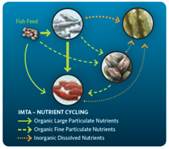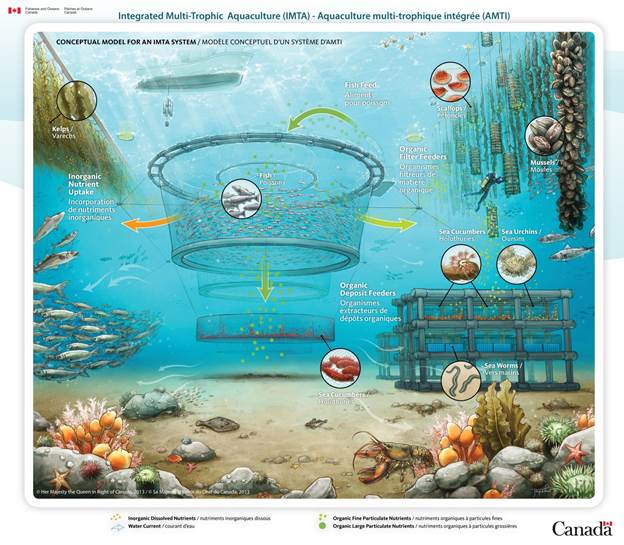Aquaculture in Canada: Integrated Multi-Trophic Aquaculture (IMTA)
Aquaculture (fish farming) already supplies approximately 50 percent of the fish and seafood consumed worldwide, and production is steadily increasing. Further development of the aquaculture industry in Canada could mean significant economic growth as well as job opportunities for Canadians – especially in coastal and rural areas. Responsible growth of the industry will depend on continued research to find innovative ways to improve the environmental performance and diversification of the sector.
Integrated Multi-Trophic Aquaculture: A new approach
Integrated Multi-Trophic Aquaculture (IMTA) is one solution that encourages greater environmental stewardship while increasing economic benefits for growers and communities. IMTA is a different way of thinking about aquatic food production that is based on the concept of recycling. Instead of growing only one species (monoculture) and focusing primarily on the needs of that species, IMTA mimics a natural ecosystem by combining the farming of multiple, complementary species from different levels of the food chain. For example, one form of IMTA is to grow fish, invertebrates (like mussels and sea cucumbers) and seaweeds close together for the benefit of each crop and the environment.
How it works
IMTA involves cultivating organisms in a way that allows the uneaten feed, wastes, nutrients and by-products of one species to be recaptured and converted into fertilizer, feed and energy for the growth of the other species. IMTA farmers combine species that need supplemental feed such as fish, with “extractive” species. Extractive species can include filter feeders (e.g., mussels) and deposit feeders (e.g., sea urchins), and seaweeds (e.g., kelps). The filter feeders and deposit feeders use the organic particulate nutrients (uneaten feed and faeces) for nourishment. The seaweeds extract the inorganic dissolved nutrients (such as nitrogen and phosphorus) that are produced by the other farmed species. Essentially, extractive species act as living filters. The natural ability of these species to recycle the nutrients (or wastes) that are present in and around fish farms can help growers improve the environmental performance of their aquaculture sites. In addition to their recycling abilities, the extractive species chosen for an IMTA site are also selected for their value as marketable products, providing extra economic benefits to farmers.
IMTA mimics a natural ecosystem by combining the farming of multiple, complementary species from different levels of the food chain.
Designing an Effective IMTA System
An effective IMTA operation requires the selection, arrangement and placement of various components or species, so as to capture both particulate and dissolved waste materials generated by fish farms.
The selected species and system design should be engineered to optimize the recapture of waste products. As larger organic particles, such as uneaten feed and faeces, settle below the cage system, they are eaten by deposit feeders, like sea cucumbers and sea urchins. At the same time, the fine suspended particles are filtered out of the water column by filter-feeding animals like mussels, oysters and scallops.
The seaweeds are placed a little farther away from the site in the direction of water flow so they can remove some of the inorganic dissolved nutrients from the water, like nitrogen and phosphorus.
IMTA species should be economically viable as aquaculture products, and cultured at densities that optimize the uptake and use of waste material throughout the production cycle.
Furthering sustainability through research
The role of Fisheries and Oceans Canada
Fisheries and Oceans Canada (DFO) facilitates the development of sustainable aquaculture in Canada, and sustainability depends on a strong scientific foundation. Scientists at DFO are examining the development potential for IMTA operations, and how this type of aquaculture could help fish farmers improve fish health and the environmental performance of their operations while maintaining economic viability. DFO is investing in this research for several reasons: to better understand and regulate the impacts of aquaculture; develop new and enhanced tools and technologies to improve fish health; and to establish sustainable, ecosystem-based practices. DFO is also using the expertise it develops with IMTA to proactively address environmental concerns with the potential scaling up of the industry.
With those objectives in mind, DFO has been involved in a number of IMTA-related research and development activities over several years. These activities fall mainly under three programs: the Aquaculture Collaborative Research and Development Program (ACRDP), the Program for Aquaculture Regulatory Research (PARR), and the Aquaculture Innovation and Market Access Program (AIMAP). Much of this research is being done collaboratively with a number of partners from the aquaculture industry, academia, federal and provincial government departments and agencies, among others.
Canadian Integrated Multi-Trophic Aquaculture Network
Prompted by the need for a concerted and strategic approach to the development of IMTA throughout Canada, the Canadian Integrated Multi-Trophic Aquaculture Network (CIMTAN) was established under the Natural Sciences and Engineering Research Council (NSERC) Strategic Network Grants program. This network involves 26 scientists from eight universities, six DFO locations and one provincial institution. CIMTAN research centers on areas of environmental system performance and species interactions, system design and engineering, and economic analysis and social implications. CIMTAN is funded by NSERC, DFO, the University of New Brunswick, and four industrial partners: Cooke Aquaculture Inc., Grieg Seafood BC, Kyuquot SEAfoods Ltd., and Marine Harvest Canada Ltd.
DFO IMTA Research Areas
Environmental System Performance
Researchers are exploring new cultivation techniques and various infrastructure designs to improve how a site operates, taking into consideration the specific hydrography of each site (e.g., currents, tides, waves). Models are being tested to help scientists predict the dispersal of farm waste and recapture of nutrients needed to achieve the right balance of inorganic and organic extractive species in an IMTA system. This information will help future IMTA sites scale up to commercial production levels.
Aquatic Animal Health
The influence of IMTA aquaculture practices on wild species, such as the effect of sea lice treatment products on sea worms (polychaetes), is being examined. Innovative research is also being done on filter-feeding bivalves, such as blue mussels, as a possible “green technology” to help control sea lice on farmed fish. By filtering out and ingesting sea lice larvae, they could potentially reduce outbreaks and limit the transfer of diseases, thus improving the overall health of the site and minimizing potential risks to wild species.
Potential IMTA species and species interactions
A variety of new species are being examined to help fill the different feeding niches within an IMTA system. Part of this research will include looking at the efficiency at which these species can consume – and incorporate into their own biomass – the nutrients produced from aquaculture activities. Species will also be evaluated with respect to the biosecurity of the aquaculture site and how they might help to naturally control parasites and pathogenic viruses and bacteria. This will help reduce the environmental impact of a site, increase profits for the growers and provide consumers with a greater variety of safe products.
The Future of IMTA in Canada: From Research to Development to Commercialization
Although IMTA in Canada is still largely in its developmental stage, collaborative research results are being used to establish best practices and improve technologies that are already being used on the farm. Products from these activities are also now coming to the market. The ultimate goal of this research is to have these innovative ideas adopted commercially by industry. IMTA practices will continue to evolve as new research is undertaken and new, innovative solutions to improve these systems are found.
Other IMTA Research Areas
Bay Management
IMTA also involves managing the ecological interactions in and around IMTA sites. Additional research will provide a better understanding of the effects of multiple IMTA sites within a larger bay area, and within the wider context of integrated coastal zone management. This research will also assist management decision-making on how IMTA farmers and other users make use of the resources contained within a given region or area.
Optimizing Species Combinations
Combinations of co-cultured species will have to be carefully selected according to a number of conditions and criteria: (1) their complementary roles with other species in the IMTA system; (2) their adaptability in relation to the habitat; (3) the culture technologies and site environmental conditions; (4) their ability to provide both efficient and continuous biomitigation; (5) the market demand for the species and pricing as raw material or for their derived products; (6) their commercialization potential; and (7) their contribution to improved environmental performance.
Within an effective IMTA system, peak production may not be achieved for any one species. Rather, the focus would be on optimizing sustainable production and the overall performance of all the combined species.
Species Interactions
This new research will look at interactions of various IMTA species. In the context of both disease prevention and disease treatment, there is a potential for shellfish, due to their filtration ability, to reduce viral, bacterial, and/or parasitic diseases in the cultured fish. There may, however, be instances where some species could potentially act as intermediate hosts and thus increase the risk to fish health. Research is needed to better understand and minimize these types of interactions.
Studies will also look at how wild species respond to IMTA species and practices, and the potential effects on their behaviour, growth and reproduction.
IMTA – A balanced, beneficial approach
Integrated Multi-Trophic Aquaculture is an experimental approach for the development of responsible aquatic food production systems, with many possible variations that can be tailored to different regions. It is adaptable for both land-based and offshore aquaculture systems in both saltwater and freshwater environments. IMTA offers a balanced ecosystem management approach that could benefit growers, the environment and society
ACKNOWLEDGEMENTS
Fisheries and Oceans Canada would like to recognize some of the early pioneers and partners in IMTA research and development including, but not limited to, the following: the Aquaculture Collaborative Research and Development Program (ACRDP) and its collaborators, AquaNet, Atlantic Canada Opportunities Agency Atlantic Innovation Fund, Atlantic Silver Ltd., members of the Canadian Integrated Multi-Trophic Aquaculture Network (CIMTAN), Cooke Aquaculture Inc., Dalhousie University, Grieg Seafood BC Ltd., Heritage Salmon Ltd., Kyuquot SEAfoods Ltd. and SEA Vision Group Inc., Marine Harvest, Memorial University, Natural Sciences and Engineering Research Council (NSERC), New Brunswick Innovation Foundation, Simon Fraser University, University of British Columbia, University of New Brunswick, University of Victoria,Vancouver Aquarium, Vancouver Island University, as well as many other scientists, students and research partners.
Integrated Multi-Trophic Aquaculture
A new approach to sustainable fish and seafood production
An Integrated Multi-Trophic Aquaculture (IMTA) farming system combines organisms from different levels of the food chain that normally share the environment – where waste from one species becomes a source of food for another.
IMTA involves farmers cultivating species that need to be fed (such as salmon), with “extractive” species (such as mussels, sea cucumbers, worms and various seaweeds). Extractive species use the organic and inorganic materials and by-products from the other species for their own growth. This mix of organisms from different levels of the food chain mimics the functioning of natural ecosystems. By recycling nutrients, this type of balanced system will ultimately provide healthier waters.
Seaweeds – the Inorganic Dissolved Nutrient Extractive Component
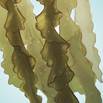
Kelps and other seaweeds naturally extract dissolved inorganic nutrients (e.g., nitrogen and phosphorus) and can help reduce the levels of dissolved inorganic nutrients generated by the other fed and non-fed components of the IMTA system. The seaweed component of the IMTA system is placed a little further away to better capture the inorganic dissolved nutrients that are lighter and travel longer distances than the organic nutrients.
Farmed Seaweed Species:
- Sugar Kelp (Saccharina latissima)
- Winged Kelp (Alaria esculenta)
Potential Species:
- Dulse (Palmaria palmata)
- Sea Lettuce (Ulva sp.)
- Nori (Porphyra sp.)
Uses of Seaweeds
- Food for other IMTA species
- Food for humans
- Products for humans
- Crop Fertilizer
IMTA species

1
2
3
4
Fish – the Fed Component
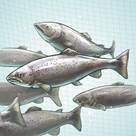
Some farmed species, such as salmon and sablefish, require manufactured feeds, small portions of which go uneaten by the fish.
All animals naturally produce organic and inorganic waste as a result of their feeding and metabolic activities. But when it comes to converting feed into body mass, fish are some of the most efficient organisms – terrestrial or aquatic – that are currently being farmed or cultured.
The wastes produced by fish, which include uneaten feed and faeces, provide high-quality nourishment for other species within the IMTA system – including wild species.
Farmed Fish Species:
Did you know?
When it comes to converting feed into body mass, fish are some of the most efficient organisms—terrestrial or aquatic that are currently being farmed or cultured.
- Atlantic Salmon (Salmo salar)
- Sablefish (Anoplopoma fimbria)
Potential Species:
- Chinook Salmon (Oncorhynchus tshawytscha)
Filter Feeders – the Organic Fine Particulate Extractive Component
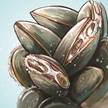
Filter-feeding bivalves, such as mussels and oysters filter the water column, feeding on micro-algae and small zooplankton and fine particulate matter. They can be used to reduce the level of finer organic particles that result from other fed or non-fed components of the IMTA system.
Farmed Filter Feeder Species:
- Blue Mussel (Mytilus edulis – Mytilus trossulus)
- Japanese Scallop (Mizuhopecten yessoensis)
Potential Species:
- Sea Scallop (Placopecten magellanicus)
- Pacific Oyster (Crassostrea gigas)
- Basket Cockle (Clinocardium nuttalli)
- Gallo Mussel (Mytilus galloprovincialis)
Deposit (or Bottom ) Feeders – the Organic Large Particulate Nutrients Extractive Component
Under an IMTA model, these are primarily invertebrates – such as sea cucumbers, sea urchins and certain worm species – that sift through sediment to feed on organic particulate matter. They can be used to recycle the larger organic particles, that result from the other (fed or non-fed) components of the IMTA system, and that settle beneath the farm site.
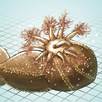

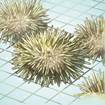

Farmed Deposit Feeder Species:
- Green Sea Urchin (Strongylocentrotus droebachiensis)
- California Sea Cucumber (Parastichopus californicus)
Potential Species:
- American Lobster (Homarus americanus)
- Clam Worm (Nereis virens)
- Blood Worm (Glycera dibranchiata)
- Northern Sea Cucumber (Cucumaria frondosa)
- Red Sea Urchin (Strongylocentrotus franciscanus)
For further information, please visit:
www.dfo-mpo.gc.ca | www.cimtan.ca
- Date modified:
